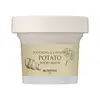What's inside
What's inside
 Key Ingredients
Key Ingredients

 Benefits
Benefits

 Concerns
Concerns

 Ingredients Side-by-side
Ingredients Side-by-side

Water
Skin ConditioningCellulose
AbsorbentGlycerin
HumectantCaprylic/Capric Triglyceride
MaskingCetearyl Alcohol
EmollientHydroxyethyl Acrylate/Sodium Acryloyldimethyl Taurate Copolymer
Emulsion StabilisingGlycol Distearate
Emollient1,2-Hexanediol
Skin ConditioningHydroxyacetophenone
AntioxidantButylene Glycol
HumectantCarbomer
Emulsion StabilisingTromethamine
BufferingLactobacillus/Hibiscus Sabdariffa Flower Ferment Filtrate
Skin ConditioningCetearyl Glucoside
EmulsifyingHydroxyethylcellulose
Emulsion StabilisingEthylhexylglycerin
Skin ConditioningSolanum Tuberosum Pulp Extract
SmoothingCaramel
Cosmetic ColorantSorbitan Isostearate
EmulsifyingSodium Hyaluronate
HumectantCentella Asiatica Extract
CleansingHydrogenated Lecithin
EmulsifyingPolyglyceryl-10 Laurate
Skin ConditioningPeucedanum Graveolens Extract
TonicDipropylene Glycol
HumectantCaffeine
Skin ConditioningGlucose
HumectantMadecassoside
AntioxidantAsiaticoside
AntioxidantMadecassic Acid
Skin ConditioningAsiatic Acid
Skin ConditioningParfum
MaskingWater, Cellulose, Glycerin, Caprylic/Capric Triglyceride, Cetearyl Alcohol, Hydroxyethyl Acrylate/Sodium Acryloyldimethyl Taurate Copolymer, Glycol Distearate, 1,2-Hexanediol, Hydroxyacetophenone, Butylene Glycol, Carbomer, Tromethamine, Lactobacillus/Hibiscus Sabdariffa Flower Ferment Filtrate, Cetearyl Glucoside, Hydroxyethylcellulose, Ethylhexylglycerin, Solanum Tuberosum Pulp Extract, Caramel, Sorbitan Isostearate, Sodium Hyaluronate, Centella Asiatica Extract, Hydrogenated Lecithin, Polyglyceryl-10 Laurate, Peucedanum Graveolens Extract, Dipropylene Glycol, Caffeine, Glucose, Madecassoside, Asiaticoside, Madecassic Acid, Asiatic Acid, Parfum
Water
Skin ConditioningSilica
AbrasivePropanediol
SolventKaolin
AbrasiveGlycerin
HumectantDiatomaceous Earth
Abrasive1,2-Hexanediol
Skin ConditioningButylene Glycol
HumectantCamellia Sinensis Seed Extract
HumectantBetaine
HumectantCarbomer
Emulsion StabilisingTromethamine
BufferingHydroxyacetophenone
AntioxidantTitanium Dioxide
Cosmetic ColorantAmmonium Acryloyldimethyltaurate/Vp Copolymer
Cellulose
AbsorbentCharcoal Powder
AbrasiveCalamine
AbsorbentCellulose Gum
Emulsion StabilisingXanthan Gum
EmulsifyingSilica Dimethyl Silylate
EmollientDisodium EDTA
Ethylhexylglycerin
Skin ConditioningEthylcellulose
Gardenia Florida Fruit Extract
Skin ConditioningDextrin
AbsorbentLauric Acid
CleansingZea Mays Starch
AbsorbentAluminum Hydroxide
EmollientMannitol
HumectantHyaluronic Acid
HumectantHydrolyzed Hyaluronic Acid
HumectantSodium Hyaluronate
HumectantPolyglyceryl-10 Stearate
Skin ConditioningSalicylic Acid
MaskingWater, Silica, Propanediol, Kaolin, Glycerin, Diatomaceous Earth, 1,2-Hexanediol, Butylene Glycol, Camellia Sinensis Seed Extract, Betaine, Carbomer, Tromethamine, Hydroxyacetophenone, Titanium Dioxide, Ammonium Acryloyldimethyltaurate/Vp Copolymer, Cellulose, Charcoal Powder, Calamine, Cellulose Gum, Xanthan Gum, Silica Dimethyl Silylate, Disodium EDTA, Ethylhexylglycerin, Ethylcellulose, Gardenia Florida Fruit Extract, Dextrin, Lauric Acid, Zea Mays Starch, Aluminum Hydroxide, Mannitol, Hyaluronic Acid, Hydrolyzed Hyaluronic Acid, Sodium Hyaluronate, Polyglyceryl-10 Stearate, Salicylic Acid
 Reviews
Reviews

Ingredients Explained
These ingredients are found in both products.
Ingredients higher up in an ingredient list are typically present in a larger amount.
1,2-Hexanediol is a synthetic liquid and another multi-functional powerhouse.
It is a:
- Humectant, drawing moisture into the skin
- Emollient, helping to soften skin
- Solvent, dispersing and stabilizing formulas
- Preservative booster, enhancing the antimicrobial activity of other preservatives
Butylene Glycol (or BG) is used within cosmetic products for a few different reasons:
Overall, Butylene Glycol is a safe and well-rounded ingredient that works well with other ingredients.
Though this ingredient works well with most skin types, some people with sensitive skin may experience a reaction such as allergic rashes, closed comedones, or itchiness.
Learn more about Butylene GlycolCarbomer is a polymer of acrylic acid. Its main role is to create a gel consistency.
A high amount of carbomer can cause pilling or balling up of products. Don't worry, most products contain 1% or less of carbomer.
Cellulose is the main component of plant cell walls. It is used as an emulsifier, absorbent, and texture enhancer.
This ingredient has many functions:
Fun fact: Cellulose is the most abundant form of organic polymer on Earth.
Learn more about CelluloseEthylhexylglycerin (we can't pronounce this either) is commonly used as a preservative and skin softener. It is derived from glyceryl.
You might see Ethylhexylglycerin often paired with other preservatives such as phenoxyethanol. Ethylhexylglycerin has been found to increase the effectiveness of these other preservatives.
Glycerin is already naturally found in your skin. It helps moisturize and protect your skin.
A study from 2016 found glycerin to be more effective as a humectant than AHAs and hyaluronic acid.
As a humectant, it helps the skin stay hydrated by pulling moisture to your skin. The low molecular weight of glycerin allows it to pull moisture into the deeper layers of your skin.
Hydrated skin improves your skin barrier; Your skin barrier helps protect against irritants and bacteria.
Glycerin has also been found to have antimicrobial and antiviral properties. Due to these properties, glycerin is often used in wound and burn treatments.
In cosmetics, glycerin is usually derived from plants such as soybean or palm. However, it can also be sourced from animals, such as tallow or animal fat.
This ingredient is organic, colorless, odorless, and non-toxic.
Glycerin is the name for this ingredient in American English. British English uses Glycerol/Glycerine.
Learn more about GlycerinHydroxyacetophenone is antioxidant with skin conditioning and soothing properties. It also boosts the efficiency of preservatives.
This ingredient is not irritating or sensitizing.
Sodium Hyaluronate is hyaluronic acid's salt form. It is commonly derived from the sodium salt of hyaluronic acid.
Like hyaluronic acid, it is great at holding water and acts as a humectant. This makes it a great skin hydrating ingredient.
Sodium Hyaluronate is naturally occurring in our bodies and is mostly found in eye fluid and joints.
These are some other common types of Hyaluronic Acid:
Learn more about Sodium HyaluronateTromethamine helps balance the pH and improve the texture of a product. It is synthetically created.
As an emulsifier, Tromethamine prevents oil and water ingredients from separating. This helps stabilize the product and elongate a product's shelf life. Tromethamine also makes a product thicker.
Tromethamine helps balance the pH level of a product. Normal pH level of skin is slightly acidic (~4.75-5.5). The acidity of our skin is maintained by our glands and skin biome. Being slightly acidic allows our skin to create an "acid mantle". This acid mantle is a thin barrier that protects our skin from bacteria and contaminants.
Oral Tromethanmine is an anti-inflammatory drug but plays the role of masking, adding fragrance, and/or balancing pH in skincare.
1,3-Propanediol, 2-amino-2-(hydroxymethyl)-
Learn more about TromethamineWater. It's the most common cosmetic ingredient of all. You'll usually see it at the top of ingredient lists, meaning that it makes up the largest part of the product.
So why is it so popular? Water most often acts as a solvent - this means that it helps dissolve other ingredients into the formulation.
You'll also recognize water as that liquid we all need to stay alive. If you see this, drink a glass of water. Stay hydrated!
Learn more about Water